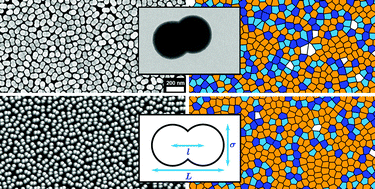Phase behaviour in 2D assemblies of dumbbell-shaped colloids generated under geometrical confinement†
Abstract
The structure formation and the phase behaviour of monolayers of dumbbell-shaped colloids are explored. For this, we conduct Langmuir–Blodgett experiments at the air/water interface and conventional Brownian dynamic simulations without hydrodynamic interactions. Using Voronoi tessellations and the probability density of the corresponding shape factor of the Voronoi cells p(ζ), the influence of the area fraction ϕ on the structure of the monolayers is investigated. An increase of the area fraction leads to a higher percentage of domains containing particles with six nearest neighbours and a sharper progression of p(ζ). Especially in dense systems, these domains can consist of aligned particles with uniform Voronoi cells. Thus, the increase of ϕ enhances the order of the monolayers. Simulations show that a sufficient enhancement of ϕ also impacts the pair correlation function which develops a substructure in its first maxima. Furthermore, we find that reducing the barrier speed in the Langmuir–Blodgett experiments enhances the final area fraction for a given target surface pressure which, in turn, also increases the percentage of particles with six nearest neighbours and sharpens the progression of p(ζ). Overall, the experiments and simulations show a remarkable qualitative agreement which indicates a versatile way of characterising colloidal monolayers by Brownian dynamics simulations. This opens up perspectives for application to a broad range of nanoparticle-based thin film coatings and devices.



 Please wait while we load your content...
Please wait while we load your content...